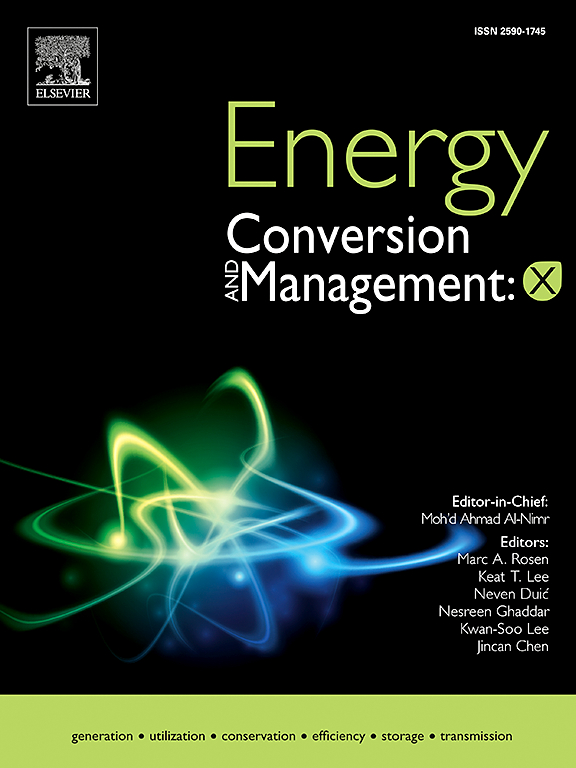State-of-the-art Gaidai hypersurface reliability assessment for semi-submersible wind turbines, accounting for memory effects
IF 7.1
Q1 ENERGY & FUELS
引用次数: 0
Abstract
Nowadays renewable, sustainable green energy generation gaining momentum, as environmental concerns, e.g., climate change making fossil fuel usage less attractive. Resultingly, offshore wave and wind power are gaining popularity, steadily replacing hydrocarbon energy sources. Floating offshore wind turbines (FOWT), being pivotal for contemporary offshore green wind energy generation.
Accurate structural lifespan prognostics is necessary for safe and resilient technological design, operational safety and economic viability. Non-stationary, multi-modal dynamic environmental wave-wind loads result in accumulated fatigue damage, as well as excessive structural deformations. Presented case study introduces generic, robust multi-modal structural reliability evaluation methodology, based on accurate numerical modelling of in-situ environmental hydro- and aero-dynamic stressors, acting on operating FOWT. Coupled aero-hydro-servo-elastic nonlinear software package OpenFAST was employed for numerical Monte Carlo Simulations (MCS). Investigated 5 MW FOWT is designed to withstand nonlinear, nonstationary, periodically adverse ambient environmental conditions throughout its complete designed service-life. This case study outlines state-of-the-art multi-modal hypersurface risk evaluation and lifetime assessment methodology.
The primary novelty and practical advantage of the proposed multi-modal Gaidai hypersurface structural risk evaluation approach lie within its robust capacity to evaluate structural damage (hazard/failure) risks for complex dynamic structural systems, with no limitation on the structural Number of Degrees Of Freedom (NDOF), i.e., the number of inter-correlated system dimensions/components.
最先进的半潜式风力涡轮机Gaidai超表面可靠性评估,考虑记忆效应
如今,可再生、可持续的绿色能源发电势头日益强劲,因为气候变化等环境问题使化石燃料的使用吸引力下降。因此,近海波浪和风力发电越来越受欢迎,正在稳步取代碳氢化合物能源。浮式海上风力涡轮机(FOWT)是当代海上绿色风力发电的关键。准确的结构寿命预测对于安全性和弹性技术设计、运行安全性和经济可行性是必要的。非平稳、多模态的动态环境波风荷载会导致累积的疲劳损伤和过大的结构变形。本案例研究介绍了一种通用的、鲁棒的多模态结构可靠性评估方法,该方法基于作用于运行中的原位环境水力和气动应力源的精确数值模拟。采用气动-液压-伺服-弹性耦合非线性软件包OpenFAST进行数值蒙特卡罗模拟。所研究的5mw FOWT在其整个设计使用寿命内都能承受非线性、非平稳、周期性的不利环境条件。本案例研究概述了最先进的多模态超表面风险评估和寿命评估方法。所提出的多模态Gaidai超表面结构风险评估方法的主要新颖性和实用优势在于其评估复杂动态结构系统的结构损伤(危害/失效)风险的强大能力,不受结构自由度(NDOF)的限制,即相互关联的系统维度/组件的数量。
本文章由计算机程序翻译,如有差异,请以英文原文为准。
求助全文
约1分钟内获得全文
求助全文
来源期刊

Energy Conversion and Management-X
Multiple-
CiteScore
8.80
自引率
3.20%
发文量
180
审稿时长
58 days
期刊介绍:
Energy Conversion and Management: X is the open access extension of the reputable journal Energy Conversion and Management, serving as a platform for interdisciplinary research on a wide array of critical energy subjects. The journal is dedicated to publishing original contributions and in-depth technical review articles that present groundbreaking research on topics spanning energy generation, utilization, conversion, storage, transmission, conservation, management, and sustainability.
The scope of Energy Conversion and Management: X encompasses various forms of energy, including mechanical, thermal, nuclear, chemical, electromagnetic, magnetic, and electric energy. It addresses all known energy resources, highlighting both conventional sources like fossil fuels and nuclear power, as well as renewable resources such as solar, biomass, hydro, wind, geothermal, and ocean energy.
 求助内容:
求助内容: 应助结果提醒方式:
应助结果提醒方式:


